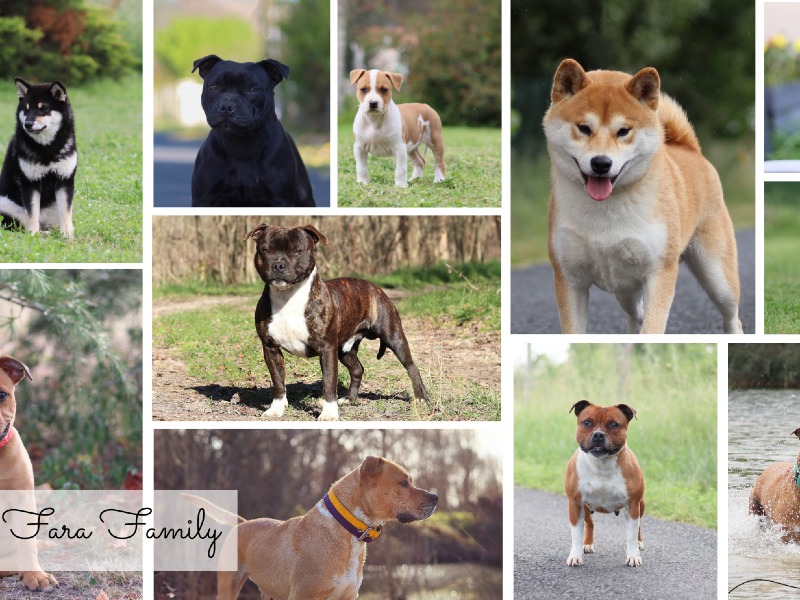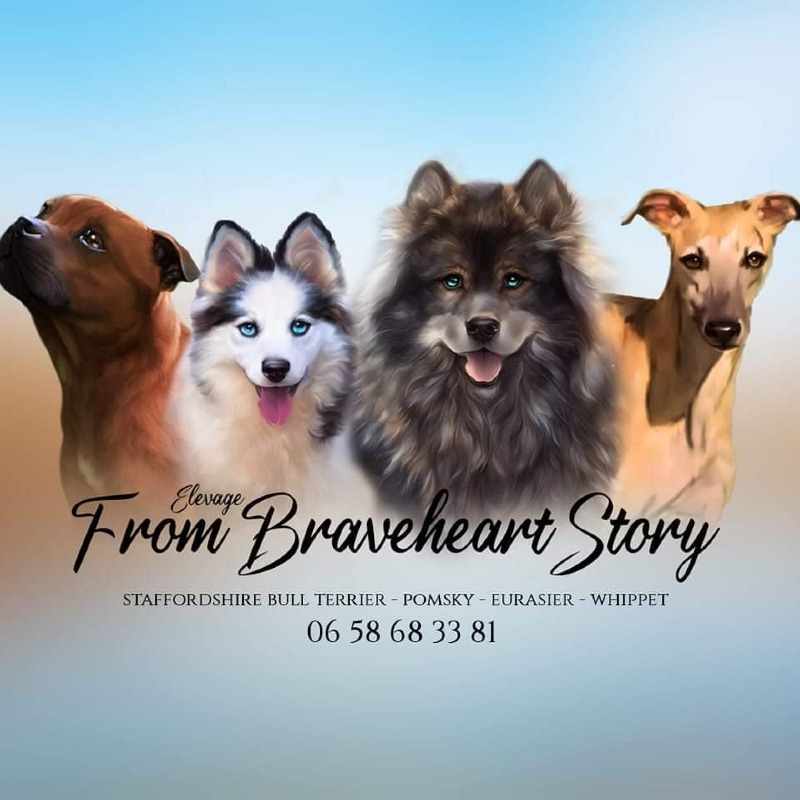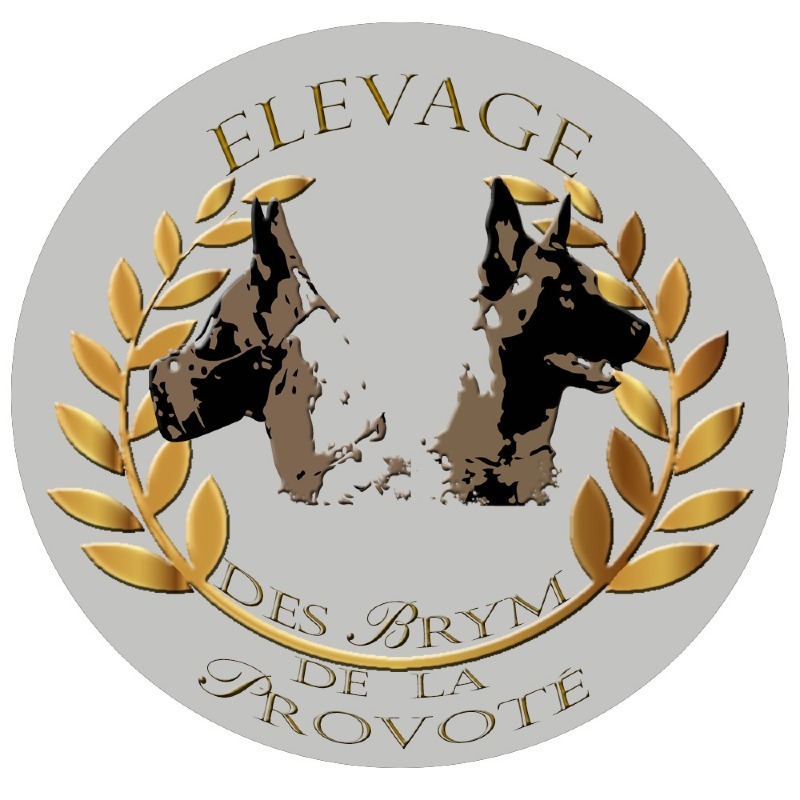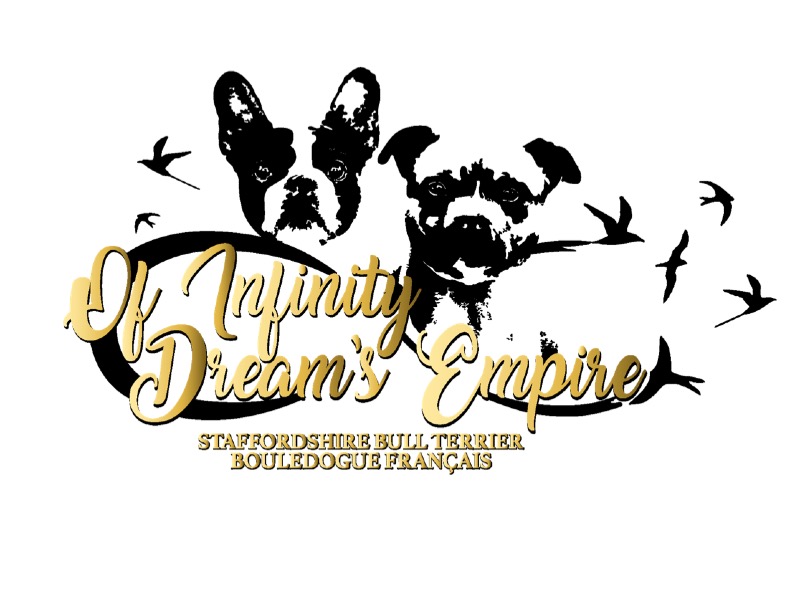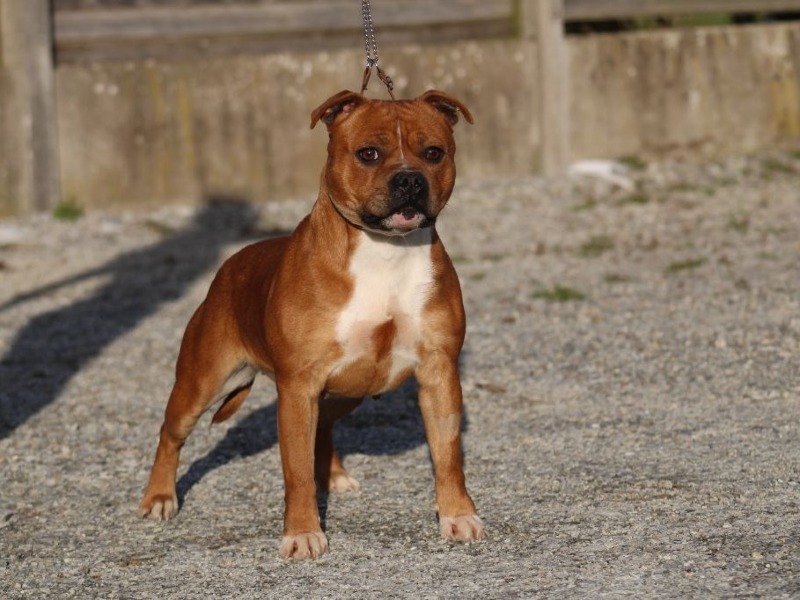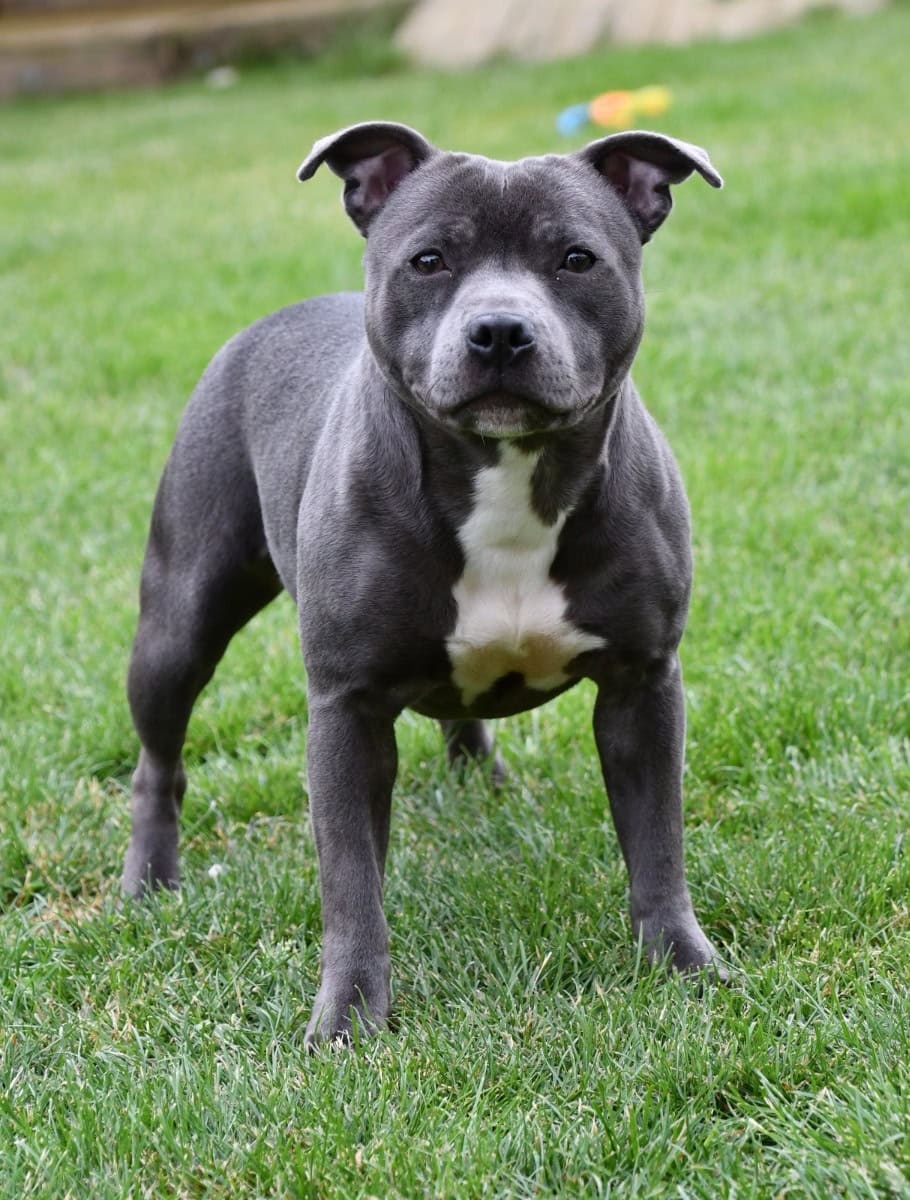Staffordshire bull terrier
Autres noms : Stafford staffy, Staffy, English staffy, Stafford bull
Discover the Staffordshire Bull Terrier, a dog breed with an affectionate nature and a vibrant personality. Loyal and protective, this energetic companion is perfect for active families. Learn all about its traits, needs, and training!
Awareness of acquiring an animal
Adopting or breeding a dog is a responsibility that must be carefully considered. Dogs are loyal companions that require time, attention, and constant care. Whether for leisure, passion, or professional breeding, it is crucial to understand the specific needs of each breed. Provide them with a loving and stimulating environment, and avoid any impulsive acquisition that could harm their well-being. Be a vigilant and committed owner for a happy and healthy companion.
To learn more about animal welfare, we invite you to consult our FAQ by clicking the button below:
Origins and history
The Staffordshire Bull Terrier has its origins in England, where it was developed starting in the 1800s. This dog is the result of crossing the Bulldog with various terriers, including the bull-type terrier. At that time, these dogs were primarily used for dog fighting and as hunting animals. Their agility, strength, and courage made them ideal companions for working activities.
Over time, the popularity of these fights raised growing concerns about animal welfare. This led to an evolution of practices and a focus on the more docile and affectionate characteristics of the breed. Breeders began to select dogs for their temperament, thus favoring traits that required less ferocity and more sociability.
Today, the Staffordshire Bull Terrier is recognized for its friendly and protective nature. Although it was originally associated with violent activities, it is now valued as a companion animal and family dog. Its intelligence, loyalty, and affinity with children make it a beloved companion in many households.
Physical characteristics
The Staffordshire Bull Terrier is a medium-sized dog, typically muscular and compact. It has a robust build, displaying a strong bone structure that gives it a sense of power. The height at the withers typically ranges from 35 to 40 centimeters, while its weight fluctuates between 11 and 17 kilograms. Its well-proportioned body is characterized by a broad and deep chest, offering good lung capacity, allowing it to be enduring.
The head of the Staffordshire Bull Terrier is broad with a well-developed skull. The cheeks are pronounced, and its muzzle is short and wide, contributing to its distinctive appearance. The eyes are round and of medium size, giving a lively and friendly expression. The ears, often cropped, are generally short and either rose-shaped or whip-shaped.
In terms of coat, it is short, smooth, and shiny, adding a touch of sophistication to its appearance. This dog comes in several colors, ranging from black and blue to red and brindle. The combination of its physical characteristics makes it an athletic and attractive dog that is easily recognizable.
Character
The Staffordshire Bull Terrier is a dog breed distinguished by its dynamic and affectionate temperament. These dogs are renowned for their loyalty to their owners, and their affection often manifests in displays of tenderness, with a strong desire to please their family. Their sociable nature generally makes them good with children, which makes them highly valued family companions.
On the other hand, these dogs can exhibit great vitality and overflowing energy. Therefore, they require regular physical activity and playtime to burn off their excess energy. A lack of exercise can lead to undesirable behaviors, which is why daily walks and play sessions are essential.
In terms of behavior, they possess a natural protective instinct, making them excellent watchdogs. They are often wary of strangers, but their balanced temperament allows them to adapt to various social situations. With consistent and positive training, Staffordshire Bull Terriers can become well-mannered and obedient companions, showcasing their intelligence and ability to learn.
Life expectancy
The lifespan of a Staffordshire Bull Terrier typically ranges between 12 and 14 years. This lifespan can be influenced by several factors, including genetics, diet, exercise, and veterinary care. Good genetics play a crucial role, as healthy lines may develop fewer health issues.
When it comes to diet, it is essential to provide high-quality food that is rich in nutrients appropriate for their age and activity level. Obesity is a common problem in these dogs, which can lead to weight-related illnesses and reduce their lifespan. Ensuring regular physical activity is also crucial for maintaining their health and overall well-being.
Regular veterinary visits help detect and prevent common diseases, such as joint problems or heart conditions. By incorporating these practices, it is possible to optimize the quality and lifespan of a Staffordshire Bull Terrier, ensuring that they remain active and happy throughout their life.
Exercise and activity needs
The Staffordshire Bull Terrier is an energetic and muscular dog breed that requires regular physical activity to maintain its physical and mental health. As a working breed, these dogs have been bred to be active, which means they need at least an hour of daily exercise. This can include walks, ball games, or other stimulating activities.
Interactive games and mental stimulation work are also crucial for this breed. Staffordshire Bull Terriers are very intelligent and thrive when they can solve problems or learn new tricks. Play training can strengthen the bond with their owner while allowing them to expend their energy.
It is essential to incorporate varied activities to avoid boredom, which can lead to destructive behaviors. Canine sports, such as agility or canicross, can provide an excellent way to channel their energy while allowing them to socialize with other dogs. In summary, a combination of physical exercise and mental stimulation is necessary for the overall well-being of the Staffordshire Bull Terrier.
Recommended diet
The diet of a Staffordshire Bull Terrier must be carefully balanced to meet its specific needs. As an active and energetic breed, these dogs require high-quality protein-rich food to promote muscle development and maintain a healthy weight. Meat, whether in the form of fresh meat or meat meal, should be at the top of the ingredient list.
It is also essential to include complex carbohydrates, such as brown rice or sweet potatoes, which provide a sustainable energy source. Fibers found in vegetables like carrots and peas contribute to healthy digestion. Essential fats, including omega-3 and omega-6 fatty acids, are important for skin and coat health, as well as for supporting the immune system.
Finally, it is recommended to divide meals into several portions throughout the day to avoid digestive issues. Special attention should be paid to hydration, ensuring that the dog always has access to fresh water. It is advisable to consult a veterinarian to establish a diet tailored to the individual needs of the animal and its activity level.
Training and obedience
Training and education of the Staffordshire Bull Terrier require a positive and consistent approach. This breed is often perceived as robust and determined, making early socialization essential. It is crucial to expose the puppy to various environments, people, and other animals from a young age to promote balanced behavior and reduce the risks of mistrust or aggression.
The training method should be based on positive reinforcement. Staffordshire Bull Terriers respond well to rewards such as treats, praise, and play. Training sessions should be short, engaging, and repetitive to maintain their attention. Using gentle discipline techniques and avoiding aversive methods is vital for establishing a trusting relationship.
Finally, it is important to maintain a clear framework. Rules should be established from the beginning and applied consistently. By creating a structured environment where the dog knows what is expected of them, emotional balance and calm behavior are encouraged. Proper education will contribute to making the Staffordshire Bull Terrier a well-adjusted, affectionate, and loyal companion.
Behavior with children
The Staffordshire Bull Terrier is often described as an affectionate and loyal dog, particularly towards children. Their generally balanced temperament makes them well-suited for family life. They often form close bonds with family members, and their affection is expressed through protective behaviors. This makes them ideal companions for young children, as they are typically gentle and patient.
However, socialization is crucial from a young age. Exposing a puppy to a variety of situations, people, and other animals helps to create a well-adjusted dog. Socialization helps to prevent undesirable behaviors and builds the dog's confidence. Additionally, positive and consistent training is essential to reinforce good manners and avoid jumping that could scare younger children.
It is also important to supervise interactions between the dog and children to ensure that they remain positive. Although this type of dog is generally friendly, children should be taught how to treat an animal. By teaching them to respect the dog's space, to avoid pulling its ears or tail, and not to disturb it while eating or sleeping, one contributes to establishing a harmonious relationship. Thus, the Staffordshire Bull Terrier can thrive in a family environment where respect and communication prevail.
Compatibility with Other Animals
The Staffordshire Bull Terrier is a dog breed that can harmoniously integrate into a household with other pets, but this depends on several factors. First, their temperament plays a crucial role. These dogs are often friendly, affectionate, and loving, but their playful and sometimes energetic nature can occasionally be misinterpreted by more reserved animals.
Introducing a Staffordshire Bull Terrier to other animals must be done with caution. Early socialization and proper training are essential to ensure peaceful coexistence. From a young age, it is recommended to expose these dogs to different species, such as cats or small rodents, to teach them how to interact appropriately.
Finally, the individual personality of each animal is decisive. Some Staffordshire Bull Terriers may have a more pronounced predatory instinct, which can be problematic with smaller animals. Therefore, constant supervision during initial encounters is essential to ensure the well-being of all pets in the household.
Grooming needs
The Staffordshire Bull Terrier is a dog breed that has a short and silky coat, which means its grooming needs are relatively modest. A weekly brushing is generally sufficient to remove dead hair and meet its maintenance needs. This brushing also helps to stimulate the skin and maintain a healthy coat. Using a short-bristle brush or a grooming mitt can make this task easier.
Regarding bathing, it is not necessary to do this frequently, as too regular bathing can dry out the animal's skin. As a general rule, bathing every few months or when absolutely necessary is enough. It is important to use dog-specific shampoos to avoid any irritation.
Finally, nail care is also crucial. It is recommended to regularly check the nails and trim them if necessary, to prevent them from becoming too long. Good dental hygiene is essential, so it is advisable to brush the dog's teeth at regular intervals to prevent dental issues. By taking care of these aspects, a good quality of life is ensured for the Staffordshire Bull Terrier.
Health
The health of Staffordshire Bull Terrier dogs presents several important aspects for owners and prospective adopters to consider. Firstly, it is worth noting that this breed is generally robust, but it can be prone to certain hereditary conditions. The most common health issues include hip dysplasia and heart problems, particularly cardiomyopathy.
Moreover, Staffordshire Bull Terriers are predisposed to skin conditions such as allergies and infections. It is crucial to monitor their skin and consult a veterinarian in case of persistent irritations. Good hygiene and regular care can help prevent many dermatological problems.
Finally, diet plays a vital role in the health of this breed. A balanced diet, rich in nutrients and suited to their activity level, is essential for maintaining their weight and preventing obesity. Regular veterinary check-ups are recommended to detect potential health problems early and ensure the well-being of these affectionate and energetic dogs.
Environment and habitat
The Staffordshire Bull Terrier is a breed of dog that thrives in an active and dynamic environment. This breed is particularly well-suited for families and enjoys the companionship of children. Its affectionate and loyal temperament makes it an excellent companion. It is important to provide them with enough space to expend their energy, as this dog requires regular exercise.
Regarding its habitat, a fenced garden is ideal for allowing it to play safely. However, it can adapt to different types of housing, whether it is an apartment or a house, as long as it has frequent outings. This dog is often sensitive to weather conditions, so it is essential to ensure that it is not exposed to extreme temperatures, whether cold or excessive heat.
Finally, early socialization is crucial for this breed. Exposing the Staffordshire Bull Terrier to various environments, animals, and people from a young age will contribute to its harmonious development and overall well-being. Good training and regular mental stimulation are also essential to prevent undesirable behaviors.
Name ideas
Choosing a name for a Staffordshire Bull Terrier is an exciting step that can strengthen the bond between you and your dog. It's essential to consider a few criteria during this selection process. First, opt for a short and punchy name, ideally one or two syllables long. Dogs respond better to simple and distinct names. Next, avoid names that sound like common commands, as this could lead to confusion during training. Lastly, choose a name that reflects your dog's personality or physical characteristics.
It can be helpful to think of themes or inspirations. You might consider the breed's origin or typical traits. Here are some suggestions to inspire you:
Rocco, Zorro, Bella, Rocky, Nala, Simba, Luna, Ace, Tyson, Dali, Juno, Gigi, Max, Coco, Tyson.
When selecting one of these names, make sure it fits your four-legged companion well. Take the time to try out several options before making your final choice, as your dog's reaction to its name can also guide you.
Average purchase price
The price of a purebred dog can vary significantly based on several factors, including origin, pedigree, and breeding. Generally, Staffordshire Bull Terriers cost between 800 and 2,000 euros when purchased from a reputable breeder. Dogs from champion lines, with particularly prestigious pedigrees, can fetch even higher prices.
It is essential to consider the additional expenses associated with dog ownership, such as vaccines, spaying/neutering, accessories, and food. These costs can easily add up and exceed several hundred euros per year.
On the other hand, adopting a dog from a shelter or rescue organization is often a less expensive alternative. Adoption fees can range from 100 to 300 euros, but they often include certain vaccinations and spaying/neutering, which is a financial advantage.
It is best to find a responsible breeder, visit the premises, and ensure that the animals' living conditions are healthy and ethical. This guarantees a thoughtful purchase that respects animal welfare.
Expenses
Owning a Staffordshire Bull Terrier involves several expenses that one should be prepared for. Generally, monthly costs can be estimated between 100 and 200 euros, depending on the choices you make regarding care, food, and activities.
Food constitutes a significant portion of these expenses. Depending on the quality of the kibble chosen, you should budget around 40 to 100 euros per month. Dogs of this breed require a balanced diet rich in proteins to support their energy levels and health.
Regular veterinary care is another important expense. Annual visits for vaccinations and check-ups can cost around 100 euros per year, which is about 8 euros per month. However, it's wise to also account for unexpected expenses, such as treatments for illnesses or accidents, which could significantly increase your budget.
Lastly, other costs such as grooming, dog accessories (bedding, toys, collars, etc.), and potential pet care when you go on vacation should also be considered, which can easily add another 30 to 60 euros per month. In short, before welcoming a dog, it is essential to thoroughly evaluate these various expense categories to ensure the well-being of the animal.
Destination and usage
The Staffordshire Bull Terrier is a dog that thrives particularly well in a family setting. This breed is favored by many families due to its friendly temperament and loyalty. These dogs are often described as affectionate and protective towards the members of their household, making them excellent companions for children.
In terms of living space, the Staffordshire Bull Terrier can adapt to both homes with gardens and apartments, provided they get enough exercise. A daily walk is essential to meet their physical and mental needs. These dogs are very energetic and love to play, which encourages positive interaction with their owners and children.
Moreover, this breed excels in canine activities such as obedience classes and agility. Their intelligence and desire to please enable them to perform well in these disciplines. Finally, the Staffordshire Bull Terrier makes an excellent companion dog, bringing joy and affection to those around them.
Legislation and regulation
The legislation regarding the Staffordshire Bull Terrier varies significantly from country to country, reflecting different cultural attitudes towards certain dog breeds. In many countries, this breed is not subject to specific restrictions, promoting a legal framework based on the owner's responsibility. In these jurisdictions, laws generally focus on dog behavior and the necessity of ensuring that they are properly trained and socialized.
However, some countries impose stricter restrictions, considering this breed potentially dangerous. In these cases, regulations may require owners to obtain a license, take out liability insurance, and ensure that their dogs wear a muzzle and leash when out in public. These measures aim to prevent incidents and ensure public safety.
Publicity campaigns highlighted by animal protection associations attempt to promote a positive image of these dogs, emphasizing the affectionate and friendly aspects of their character. These efforts seek to raise awareness about the necessity of proper dog training rather than stigmatizing certain breeds.
Official recognition
The official recognition of the Staffordshire Bull Terrier breed varies significantly from country to country. In many countries, this breed is fully recognized by national and international canine organizations, allowing it to participate in shows and competitions. For example, in Great Britain, the breed is recognized and widely appreciated, with a history tracing back to the 19th century. Dogs of this breed are often regarded as affectionate and loyal.
However, some countries impose restrictions or bans on this breed due to safety concerns and public perception. In nations such as certain U.S. states or European countries, laws may limit the ownership of the breed because of stereotypes associated with its strength. This situation creates a disparity in the perception and interaction with the breed, even among breeders and owners.
On an international scale, organizations like the Fédération Cynologique Internationale maintain standards that are respected by many countries. This ensures a certain level of uniformity in judging dogs during competitions, but the legal and social implications can vary immensely, affecting the popularity and status of the breed worldwide.
Pedigrees
To obtain a pedigree for a Staffordshire Bull Terrier, it is essential to turn to recognized clubs and registries that manage the breed standards. The main governing body in France is the Société Centrale Canine (SCC). The SCC is responsible for the registration of purebred dogs and issues official pedigrees, ensuring traceability and genetic quality of the specimens.
Additionally, breed clubs play a crucial role in promoting and preserving the characteristics of this breed. The Club Français du Staffordshire Bull Terrier (CFSTBT) is one of the main associations dedicated to this breed. It organizes events such as dog shows and manages information related to bloodlines and litters. Becoming a member of such a club can provide additional benefits, such as access to advice on breeding and the health of the breed.
Finally, other international registries, such as the American Kennel Club (AKC) or the Fédération Cynologique Internationale (FCI), can also issue pedigrees for Staffordshire Bull Terriers, but it is recommended to focus on national structures to ensure local recognition.
Prohibitions
Laws regarding dog breeds such as the Staffordshire Bull Terrier vary significantly around the world. In some countries, strict bans have been implemented, considered as public safety measures. For example, nations like France and Germany impose restrictions on the ownership of certain breeds deemed potentially dangerous. These laws may include requirements for sterilization, muzzling, and licensing for owners.
In other regions, such as certain states in the United States, regulations may depend on local levels. Some municipalities choose to specifically prohibit so-called "dangerous" breeds, while others focus on the individual behavior of the dog rather than the breed itself. The United Kingdom, on the other hand, has implemented laws that prohibit certain specific breeds, but the Staffordshire Bull Terrier is not on that list.
Finally, movements are forming in various countries to criticize these bans, arguing that holding owners accountable is a more effective approach than one that focuses solely on the breed of the dog. Awareness and education are therefore crucial elements in the debate surrounding restrictions on certain breeds.
Breeders of Staffordshire bull terrier
Want to see more breeders of Staffordshire bull terrier?
Check out the page of our directory listing all breeders of Staffordshire bull terrierClassified Ads of Staffordshire bull terrier
Want to see more ads of Staffordshire bull terrier?
Check out the page listing all the ads of Staffordshire bull terrierBreed clubs of staffordshire bull terrier
No of staffordshire bull terrier breed clubs are currently registered on Preeders.
If you would like to highlight your breed club, sign up for free now and be the first to appear on this page.



